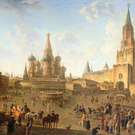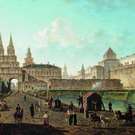Tour to Tretyakov Gallery in Moscow 2023.
English Tour to Tretyakov Art Gallery could be followed or preceeded by many tours in Moscow Angel offers. English Tour to Tretyakov Art Gallery lasts 1,5-2 hrs and is available Tue - Sun. During the Tretyakov Gallery Tour you'll see crème de la crème of the Tretyakov Gallery.
The Tretyakov Gallery is a world famous treasury of Russian fine arts. In a century and a half, the Tretyakov Gallery has grown from a private collection to a major art museum. Hundreds of thousands of tourists take tours to The Tretyakov Gallery every year to see its masterpieces.
The Tretyakov Gallery was est. in 1856, when P. Tretyakov, a 24-yo Moscow merchant, bought a number of paintings by his contemporary Russian painters. Then he bought paintings of Morozov, Pukirev and other. From the 2H of the 19th cen. this predetermined the preference in expanding the Tretyakov Gallery collection. Tretyakov was especially interested in the works of V. Perov. His paintings 'Easter Procession' and 'Troika' are the among the highlights of the Tretyakov Gallery tour. In 1870-s Tretyakov comissioned portraits of 'the best people of Russia' to Perov, Kramskoi, Repin for the Tretyakov Gallery. A landmark in the history of Tretyakov's gallery was the purchase of the 'Turkestan series' by Vereshchagin. Later Tretyakov bought from the artist for the gallery his best paintings from Indian and Balkan series. The Tretyakov gallery owns the most complete collection of works by the master.
Tretyakov's collecting activity for his gallery reached its pinnacle in 1880s. In 1892, Tretyakov donated his gallery to Moscow (approx. 2000 paintings, drawings and sculptures). Owing to Tretyakov the Gallery has acquired about 40 works by Repin. Tretyakov became the main buyer of the works of Vasnetsov. After each Itinerants' exhibition the Tretyakov Gallery bought their paintings. Tretyakov continued his activity also after his collection and the collection of his brother were donated as the Tretyakovs' Gallery to Moscow. Tretyakov published Tretyakov Gallery Guide for 3 years. The last Tretyakov Gallery Guide compiled by Tretyakov in 1898, listed 1056 paintings, including the portrait of Tchaikovsky.
Tretyakov with interest observed the work of landscape painters. After Tretyakov's death, the Gallery Board still bought them.
After the Revolution the Tretyakov Gallery increased due to the merger of the Tretyakov Gallery with "small" museums and transfer of works from nationalized private galleries. Later an active acquisition policy the Tretyakov Gallery contributed to systematic replenishment of the collection of classical Russian painting, even though initially it seemed that this aim was already reached by Tretyakov.
Today the Tretyakov Gallery displays nearly 700 paintings of the 2H of the 19 cen. only part of which (the highlights, including the largest canvass of the Tretyakov Gallery) can be covered during a standard Tretyakov Gallery tour. The most significant paintings never leave their halls. However hosts exhibitions regularly appear in the Tretyakov Gallery. Temporarily missing items can be "replaced" with paintings from the Tretyakov Gallery funds.
We are glad to offer you English Tour to Tretyakov Art Gallery in Moscow, the most famous and the most comprehensive art gallery of Russian art from the medieval centuries to 20th cen. You'll get impressed by the beauty of Russian art.
Throughout his entire life, Tretyakov remained a shrewd businessman. It was not the patronage of the arts nor his addiction to collecting but the idea, typical of his time, of giving back to the society, which he understood in his own way which inspired Tretyakov. "From my youth up," Tretyakov wrote to his daughter, "my idea was to accumulate wealth with the aim of giving back to the society what I had earned from the very same society."
Tretyakov’s contemporaries marveled at the native wit and perfect taste of this hereditary merchant. Tretyakov received no formal education (the Tretyakov brothers were educated at home) but was knowledgeable in literature, art, theater, and music. "Tretyakov was a scholar in his nature and knowledge," (A. Benois, History of Russian Art, 1902).
Tretyakov knew a lot of painters, writers, musicians and was friends with many of them. Tretyakov listened to their advice and comments but always got his own way and usually did not change his mind. Tretyakov didn't allow anyone to guide him in his own business. His good taste, strict choice, and purity of intents gave Tretyakov the deserved and undeniable prestige and privileges that no other collector had: he obtained the right to be the first who could look at new works of painters either in their studios or at exhibitions. Tretyakov's visits to artists were always an exciting event.
In 1877 Ilya. Repin wrote to Pavel Tretyakov: "I must frankly admit that if I sell the painting, I will only sell it to you, since I have nothing against placing it in your gallery." If Pavel Tretyakov did not start his collection of Russian art, we would probably not know many of the paintings in the Tretyakov Gallery. Tretyakov was the only one who supported everything new, fresh, and positive in Russian art.
Every year dozens, if not hundreds, of new paintings were added to Tretyakov's gallery. Tretyakov bought even if a painting did not meet his own views but was in tune with the times.
Tretyakov clearly understood that his gallery should reflect the actual pattern of development of Russian art. It might be the reason why Tretyakov’s taste was not narrow and limited.
Tretyakov preferred contemporary art; but he acquired earlier art works. He established the first Russian gallery showing the progress of Russian art.
Tretyakov primarily created a picture gallery (its collections of sculpture and graphic art were significantly enlarged after the death of Tretyakov). The works purchased by him constitute a gold reserve not only of the Tretyakov Gallery but of world art as well.
At first Tretyakov's gallery was kept in his house, where the Tretyakov family lived.
In 1868 P. Tretyakov commissioned statue Neapolitan Boy with a Monkey by Laveretsky in marble, the first piece in Tretyakov Gallery's rather small sculpture collection.
In 1871-1872 Perov's images of "people dear to the nation", incl. Ostrovsky, Dostoevsky, Dahl were commissioned by P. Tretyakov for Tretyakov's gallery.
In 1872, when Tretyakov bought new paintings he decided to build a special building for the gallery. In March 1874, the paintings were moved to the 2-storied gallery. On the first floor of the Tretyakov’s gallery, works of the "old masters' were placed.
In 1882 Tretyakov’s gallery was again expanded. The 1st floor of the added gallery hosted Vereshchagin’s paintings and sketches from India. Surikov's, Savrasov’s and other painters’ works were housed on the 2nd floor of the added gallery. In 1882 the Tretyakov's gallery collection was granted the status of a museum.
Another 2-story extension was added to Tretyakov’s gallery in 1892 with works of late 1880s and early 1890s, incl Levitan’s, incl. ‘Vladimir Road’, (donated to Tretyakov’s gallery) and a sketch for ‘Eternal Peace’ (Tretyakov's last acquisition).
In August of 1892, Tretyakov donated his collection, along with the collection gathered by his younger brother, Sergei Tretyakov (the Mayor of Moscow in 1880s, he mainly bought works by West European artists, they are kept in the Pushkin State Museum of Fine Arts and the Hermitage), to the city of Moscow. A year later the gallery was named the Pavel & Sergey Tretyakov Moscow Art Gallery.
Moscow City Duma, which now was the legal owner of the Tretyakov Gallery, appointed Pavel Tretyakov the Tretyakov Gallery's curator for life. Tretyakov constantly expanded the gallery's collection by buying new works of art. He also continued expanding the display space of the Tretyakov Gallery. In 1893-1897 Tretyakov donated over 200 more paintings to the gallery. "As a token of deepest gratitude for the artistic pleasure and aesthetic education given to the people of Moscow and all Russia by the treasures collected through the efforts of Pavel Tretyakov" the Moscow City Duma named Tretyakov honorary citizen of Moscow.
After Tretyakov's death, the Tretyakov Gallery was managed by a Board of Trustees headed by Moscow mayor. The first issue for the Board was the question about the Tretyakovs' house. Its living area was linked to the main space of the Tretyakov Gallery. In 1899 Tretyakov's heirs gave to the gallery over 62 icons.
In the early 20th cen. the Tretyakov Gallery became a largest museum not only in Russia but also in Europe. From 1913 on the initiative of Igor Grabar, the gallery's curator (in 1918-1925 he headed the Tretyakov Gallery), paintings were hung in a new arrangement according to chronological (ealier, newly acquired works of art were exhibited separately from Tretyakov's main collection).
A new period in the history of the Tretyakov Gallery began after the October 1917 Revolution. In 1918 it was named the State Tretyakov Gallery. In 1920-1930s the Tretyakov Gallery grew into a large scientific and educational center. A department of education was set up at the Tretyakov Gallery to organize lectures and tours in Moscow. Due to nationalization of private museums the number of exhibits of the Tretyakov Gallery quintupled by 1930s. A collection of paintings by Soviet artists began to be formed when paintings from the "Artists of the RSFSR over 15 Years" and "15 Years of the Red Army" art exhibitions were transferred to the Tretyakov gallery.
From the first weeks of the Great Patriotic War the main task of the Tretyakov Gallery's staff was to save the collection. A week after Victory Day a new exposition was opened at the Tretyakov Gallery with more than 2500 works of art on display.





